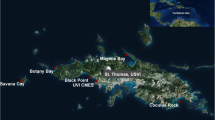Abstract
To determine what happens to scleractinian corals that have been killed by black band disease (BBD), massive corals with BBD were monitored for 11 years on a shallow reef (<10 m depth) in St. John, US Virgin Islands. Small quadrats (0.039 m2) were used to compare the rates of scleractinian recruitment to the skeletons of corals killed by either BBD or physical disturbance (Hurricane Hugo 1989). Coral recruitment was also quantified on the adjacent fringing reef using larger quadrats (0.25 m2) to detect possible biases associated with using small, permanent quadrats to assess recruitment to BBD-killed corals. Of 28 tagged colonies with BBD in 1988, 43% were lost to Hurricane Hugo in 1989, 7% were lost to unknown causes between 1991 and 1992, and 14 were monitored annually for 11 years; of these, 71% were dead and still in their original growth position in 1998. Between 1988 and 1997, corals recruited to the BBD-killed surfaces at a rate of 1.1 ± 0.3 recruits · 0.039 m−2 · decade−1 (mean ± SE, n = 14), although mortality reduced the density to 0.3 ± 0.2 recruits · 0.039 m−2 by 1997. The rate of recruitment and the taxonomic composition of the coral recruits to BBD-killed corals were indistinguishable statistically from those to corals killed by Hurricane Hugo. This demonstrates that BBD creates space that is functionally the same as other dead coral surfaces in providing a substratum for coral recruitment. However, because coral recruits are dispersed widely, clumped in distribution and temporally variable in density on the fringing reef as a whole, it is unlikely that they will be found on monitored coral colonies that have been killed by BBD. While this hypothesis is consistent with the higher density of recruits on the fringing reef compared with BBD-killed corals, further studies are required to investigate alternative explanations such as the role of substratum age in favoring recruitment to surfaces other than those killed recently by BBD.
Similar content being viewed by others
Author information
Authors and Affiliations
Additional information
Accepted: 26 August 1999
Rights and permissions
About this article
Cite this article
Edmunds, P. Recruitment of scleractinians onto the skeletons of corals killed by black band disease. Coral Reefs 19, 69–74 (2000). https://doi.org/10.1007/s003380050229
Issue Date:
DOI: https://doi.org/10.1007/s003380050229




